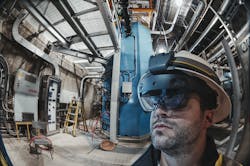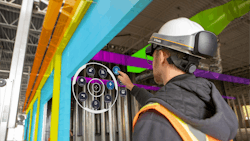The integration and use of mixed reality technology in the electrical construction industry is no longer a futuristic concept. It has crossed the chasm from the days of early adoption a few years ago to an integral part of the connected construction workflow — and continued growth is expected. Research from IDC found that spending for augmented and extended reality increased by 78.5% between 2019 and 2020, and the market is set to see a compound annual growth rate of up to 77% through 2023.
Mixed reality technology merges real and virtual worlds to create brand new environments where physical and digital components can interact simultaneously. It’s considered “mixed” reality because it encompasses both virtual and real environments via immersive technology, enabling users to see the existing space overlaid with holographic data from a 3D model.
While the original vision of connecting digital and physical worlds took decades to develop, it has now become an integral tool to improve efficiency that delivers a proven return on investment for electrical engineers and contractors.
Mixed reality is transforming the way electrical engineers and contractors consume and interact with information, letting them go beyond the constraints of a 2D screen by superimposing the digital model on the physical environment to provide a clear understanding of the design intent. This capability is especially helpful because it gives project teams the detail and the perspective they need to understand and visualize the design in the context of the physical job site before they start the work and mitigate any clash detection/overlap before construction crews arrive on site.
Immersive visualization
Mixed reality simplifies and accelerates access to building information modeling (BIM) data on the job site — anytime, any place. This way, workers can leverage mixed reality to compare plans against work completed. Advanced visualization extends the ability for users to view assigned tasks and capture data with on-site measurement tools. This reduces human error, making projects much more efficient.
This technology also helped electrical contractors overcome the COVID-19 travel restrictions by giving clients the ability to visualize the progress of their project and to align with all stakeholders on any design adjustments or changes from remote locations.
Using mixed reality technology, an apprentice can view the current condition, review the steps necessary to complete the task, and resolve any issues. As a result, electrical contractors benefit by reducing costs, accelerating project schedules, and improving the quality of their work. Another benefit of mixed reality technology is the ability to conduct remote assistance with technicians and provide 3D guided sequencing, which reduces the time needed for training and minimizes the possibility of errors during the assembly process.
Improved efficiency and quality assurance/control
Mixed reality technology is being used in the electrical industry for a variety of purposes, such as remote site walks, quality assurance and quality control, clash detection, install verification, project controls, and remote assist.
Electrical contractors benefit from the ability to visualize 3D models in an immersive environment to communicate and collaborate with others — both collocated and remote — while immersed in the design. In addition to clash detection, mixed reality applications overlay designs in the real world to simplify tasks (such as renovation visualization) and train workers and field crews to virtually explore their assignments before actual construction begins. For example, users can superimpose transmission and distribution line designs against the backdrop of the real world to visualize and validate designs. They can also review lighting designs superimposed on future sites with their customers and crew to validate details like light pole configuration and placement before construction.
Understanding the design in context can also increase confidence and reduce rework by effectively conveying and clarifying design intent and impact to all stakeholders.
Real-world examples
Indiana-based Bowen Engineering is one company that is reaping big benefits from the use of mixed reality technology. A majority of the company’s work takes place in existing facilities that are already packed with infrastructure, making it difficult to find a viable route to install new utilities. The work is often installed in very tight spaces, and it can be difficult to accurately verify tie-in points and avoid clashes with existing elements in the facility. Using a mixed reality solution helped the Bowen Engineering team visualize its designs and drawings in 3D while on the job site, significantly improving the company’s pre-planning process and workflow.
“We put on the XR10 with HoloLens 2 and right away noticed that one of our T-posts was hitting a valve and needed to be shifted over,” said Colton Motz, project engineer at Bowen Engineering. “It looked clear in the model, but when we walked the site (overlayed with the model) and could actually see it and touch it, we could see right away that what was in the model wasn’t going to work.”
Bowen Engineering managers estimate that mixed reality technology saved them more than $4,000 in labor costs on one project alone by helping them discover an issue that, if left undiscovered, would have required an additional 16 to 24 hours of crew time between delays and rework.
In another instance, Montreal-based MA-TH, an engineering firm, was experiencing many misinterpretations of engineering documents, including BIM models and point clouds, that resulted from a lack of knowledge of common software and data extraction. The company used mixed reality technology to implement a process for design review that allowed the client and its operating team members to preview their project on site and reduce the risk of misunderstanding the BIM model or engineering documents. This resulted in cost savings of more than $25,000 in site modifications that were identified during the design review process.
“Before, our clients could only visualize their projects on a computer screen, but now they can easily walk the site and see firsthand all of the details of the design,” said Félix Therrien, co-founder of MA-TH.
Connected construction democratizes the model
With the integration of mixed reality technology taking root, what does the construction site of the future look like? Although it provides extreme value in the field, mixed reality technology also eases the process of sharing project information with those in the office. Using hardware and software connected to the cloud makes the model available to more people so stakeholders across a project can collaborate on all different types of design files together in a common location.
Electrical engineers can also leverage their investment in BIM by using mixed reality to grow the capabilities of the technology and get more value out of their data. With two-way communication, users always have the most up-to-date data on their site, which accelerates decision making and reduces downtime by enhancing communication and collaboration between local and remote teams. In addition, the ability to use this type of technology via hard hat-compatible hardware allows workers to have their hands free so they can view the models and install wiring or conduits at the same time.
The innovation in mixed reality technology doesn’t stop here. As more widespread adoption occurs, the democratization of the model makes data more accessible to more people than ever before. By enabling everyone to visualize the same desired result, teams can develop a shared understanding of the project and the work to be completed, enhancing communication and coordination to improve productivity and reduce costly rework.
Jordan Lawver is the Business Area Director, AR/MR/VR at Trimble Inc. He has led the product management and marketing activities for Trimble Building's mixed-reality product portfolio for the last four years, including tools such as Trimble Connect for HoloLens and Trimble XR10 with HoloLens 2. Prior to his work in mixed reality, Jordan completed Trimble's Rotational Leadership Development program, worked on NASA's Mars Rover and LRO programs, and received engineering degrees in computer vision, photogrammetry, and surveying from The Ohio State University.
About the Author

Jordan Lawver
Jordan Lawver is the Business Area Director, AR/MR/VR at Trimble Inc. He has led the product management and marketing activities for Trimble Building's mixed-reality product portfolio for the last four years, including tools such as Trimble Connect for HoloLens and Trimble XR10 with HoloLens 2. Prior to his work in mixed reality, Jordan completed Trimble's Rotational Leadership Development program, worked on NASA's Mars Rover and LRO programs, and received engineering degrees in Computer Vision, Photogrammetry, and Surveying from The Ohio State University.




